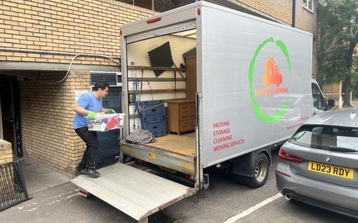
Moving to a new home can be an exciting milestone, but the process of packing up your belongings often feels overwhelming. From deciding what to take to ensuring fragile items stay intact, the challenges can pile up quickly. However, with the right strategies, you can transform this daunting task into a smooth and efficient experience. In this blog post, we’ll share expert packing tips that not only save you time but also reduce stress, helping you achieve a hassle-free move.
Start Early for a Stress-Free Move
CALL US ANY TIME BY 020 3633 4324
1. Start Early and Plan Ahead
One of the biggest mistakes people make when moving is underestimating how long packing will take. Procrastination can lead to a rushed and chaotic experience, so it’s crucial to start early. Ideally, begin packing non-essential items several weeks before your moving date.
Create a packing schedule:
- Weeks 6-4 Before Move: Start with seasonal or rarely used items like holiday decorations, extra linens, or books.
- Weeks 4-2 Before Move: Move on to non-daily essentials, such as kitchen gadgets, artwork, and out-of-season clothing.
- Week Before Move: Focus on daily use items but keep a suitcase with essentials for the first few days in your new home.
Breaking the task into smaller, manageable chunks helps avoid burnout and ensures you’re not scrambling at the last minute.
2. Declutter Before You Pack
Packing is an excellent opportunity to declutter and get rid of items you no longer need. The less you have to move, the easier and cheaper your relocation will be.
Sort Your Belongings:
- Keep: Items you use regularly or have sentimental value.
- Donate: clothing, furniture, or household items in good condition that you no longer need.
- Recycle or Trash: broken, outdated, or unusable items.
Use the “one-year rule” for guidance: If you haven’t used an item in the past year, consider parting with it. Decluttering not only streamlines your move but also helps you start fresh in your new home.
3. Invest in Quality Packing Supplies
Using the right materials is key to keeping your belongings safe during transit. While it might be tempting to cut costs by using old or flimsy boxes, this can lead to damage or complications during the move.
Essential Packing Supplies:
- Sturdy Boxes: Opt for various sizes and ensure they’re in good condition.
- Packing Tape: Use heavy-duty tape to secure your boxes properly.
- Bubble Wrap and Packing Paper: Protect fragile items like dishes, glassware, and electronics.
- Labels and Markers: Mark each box with its contents and destination room.
- Furniture Covers and Stretch Wrap: Safeguard larger items like sofas and mattresses from dirt and damage.
Pro tip: Many moving companies, like Experience Removals, offer packing supplies as part of their services, saving you time and effort.
4. Pack Room by Room
A systematic approach is vital for staying organized. Packing room by room ensures that items stay grouped together, making unpacking easier and more efficient.
Tips for Room-by-Room Packing:
- Start with Least Used Rooms: Begin with areas like the attic, garage, or guest bedroom.
- Label Clearly: Write the room name and a brief description of the contents on each box. For example, “Kitchen: Pots and Pans.”
- Use Color-Coding: Assign a color to each room and use colored tape or labels for quick identification.
This method minimizes confusion when unloading boxes and helps movers place them in the correct locations in your new home.

5. Pack Fragile Items with Care
Fragile items require extra attention to prevent breakage during the move. Using the right techniques and materials can make all the difference.
Best Practices for Packing Fragiles:
- Wrap Each Item Individually: Use bubble wrap, packing paper, or even clothing to cushion delicate items.
- Use Dividers for Glassware: Inserts for wine glasses or mugs can prevent them from shifting and breaking.
- Double-Box Fragile Items: Place wrapped items in a smaller box, then nest that box within a larger one filled with padding.
- Label as Fragile: Clearly mark these boxes to ensure careful handling.
For highly valuable or sentimental items, consider transporting them yourself instead of placing them in the moving truck.
6. Maximize Space and Weight Distribution
Efficient packing isn’t just about fitting everything into boxes—it’s also about using space wisely and balancing weight.
Space-Saving Tips:
- Use Suitcases for Heavy Items: Pack books or other weighty items in rolling suitcases for easy transport.
- Vacuum-Seal Clothes and Linens: Save space by compressing bulkier items like bedding and winter jackets.
- Fill Empty Spaces: Use towels, socks, or small items to fill gaps in boxes and prevent shifting.
Weight Distribution:
- Keep Boxes Manageable: Avoid overpacking; aim for a maximum weight of 50 pounds per box.
- Distribute Weight Evenly: Place heavier items at the bottom and lighter items on top.
This approach minimizes the risk of boxes breaking and makes loading and unloading more efficient.
7. Use a Packing Checklist
A detailed checklist can keep you on track and ensure you don’t overlook anything important.
Sample Packing Checklist:
Checking off tasks as you go provides a sense of accomplishment and keeps the process manageable.
8. Prepare an Essentials Box
Your first day in a new home can be hectic, and the last thing you want is to dig through boxes for basic necessities. Pack a separate essentials box with items you’ll need immediately.
What to Include:
- Toiletries (toothbrush, toothpaste, soap).
- Basic kitchen supplies (plates, utensils, coffee maker).
- Important documents (IDs, lease agreements).
- Medications and first aid kit.
- Chargers and electronics.
- A change of clothes and bedding.
Keep this box with you during the move to ensure easy access.
9. Label and Inventory Your Boxes
Detailed labeling and inventorying simplify both the moving and unpacking processes.
Labeling Tips:
- Clearly mark each box with its contents and destination room.
- Use “Fragile” and “This Side Up” labels where applicable.
Inventory List:
- Keep a master list of all packed boxes and their general contents.
- Use a numbering system to track boxes and ensure nothing gets lost.
There are also packing apps that can help you digitally inventory your items for added convenience.
10. Consider Professional Packing Services
If time is tight or you’re dealing with complex items like antiques or large furniture, hiring professionals can be a game-changer. Companies like Experience Removals offer expert packing services that ensure your belongings are safely and efficiently prepared for the move.
Advantages of Professional Packers:
- Save time and effort.
- Expertise in handling fragile and valuable items.
- Access to high-quality packing materials.
Professional packing services can give you peace of mind and allow you to focus on other aspects of your move.
Conclusion
Efficient packing is the foundation of a hassle-free move. By starting early, decluttering, using quality materials, and following a systematic approach, you can minimize stress and ensure your belongings arrive safely at your new home. Whether you’re moving across town or to a new state, these strategies will help you stay organized and make the process as smooth as possible.
For additional support, consider reaching out to Experience Removals. Our expert team offers comprehensive moving services, including packing, transportation, and unpacking, to make your transition seamless. Contact us today to learn how we can simplify your move!






